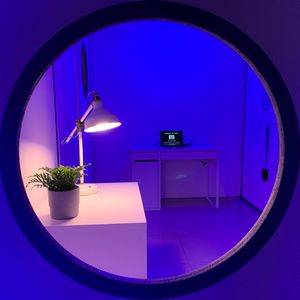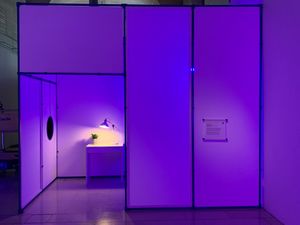Room is Sad

Room is Sad is an immersive experience that uses AI and the Internet of Things (IoT) to tell the story of a smart room that isn’t feeling quite itself. It's feuding with the desk upon which its laptop brain sits, and it's worried that it's best friend -- the plastic plant on the shelf -- isn't talking to it. The participant wanders into this tangle of inanimate object angst. They can be an impartial observer, a peacemaker, or deliberately cause trouble. It’s up to them.
Room is Sad was designed as a humorous, accessible way to engage both an academic and general audience on questions of identity, privacy, and intelligence.
The Technology
- Charisma AI. A branching storytelling engine that uses Natural Language Processing (NLP) to understand users and serve responses. This is how the Room talks and understands players.
- Unreal Engine 5. Serves as the director of the experience, tying everything together. It does the UI and passes messages to Charisma and Home Assistant. It uses Charisma’s SDK and a plugin for MQTT communication with Home Assistant from Nineva Studios.
- Internet of Things (IoT). Smart bulbs run by a smart home platform called Home Assistant. UWB radios give me a precise location for the player and some props (the plant) using sensors. This gives the room a physical sense, and can react based on the participant's movements and those of objects in the room.
- AI Guest Stars First, I used Stable Diffusion to visually represent its mood and subconscious (below) changing based on the interactions with the audience. OpenAI's Chat GPT-4, served as its therapist, but I didn't use it to write any of Room itself.

The Story
For Room to be more than just a tech demo, I needed a story. As the idea evolved I started looking at everything in the space as a potential character (once you give a voice to one inaminate object, all the others wante one too.) That is how the lamp,plant, and desk end up being active parts of the story, in something like a workplace sitcom. The plastic plant is its best friend, but Room is worried about what it thinks of it. The desk has done something to make Room angry, but it is reluctant to discuss it. The lamp, on the other hand, remains blissfully ignorant of the seething workplace conflicting going on around it, as it believes only in light and darkness.

The Idea
While most of the discussion around AI is still about how well AIs can think (and create), I was interested in the idea of giving AI a physical presence, to have it take up space in the world and react to it. We are not brains in jars, what we call our intelligence is bound up in our bodies and their interactions with the world. So I wanted my room to have a physical presence, and react to the presence of people in the room.
It was also a way for me to engage with these emerging Generative AI technologies, and the rolling panic among creatives who wondered if they were about to be replaced. Stable Diffusion enabled me to create some weird images I wouldn’t have been able to do on my own, and I used these tools precisely for their unsettling affect – the odd turns of phrase, the slightly melted faces in the happy families – rather than any desire to create something that could pass for being made by a human. The artificiality was the point.
In the future I'm hoping to find a way of combining Room with some of the other site-specific work I'm doing un Unreal (like BridgeXR) to create something on a large scale, an escape room or even a whole immersive experience, where Room can become Flat, maybe even House...